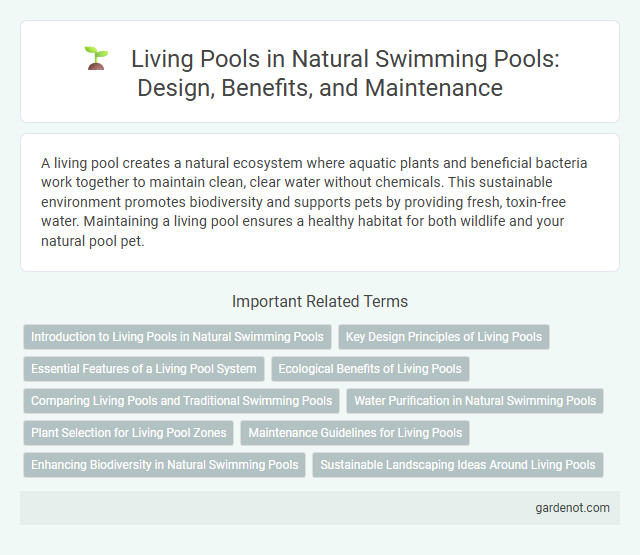A living pool creates a natural ecosystem where aquatic plants and beneficial bacteria work together to maintain clean, clear water without chemicals. This sustainable environment promotes biodiversity and supports pets by providing fresh, toxin-free water. Maintaining a living pool ensures a healthy habitat for both wildlife and your natural pool pet.
Introduction to Living Pools in Natural Swimming Pools
Living pools are a natural swimming pool design that integrates biological filtration systems using aquatic plants and beneficial microorganisms to maintain water clarity and balance without chemicals. These pools mimic natural ecosystems, promoting biodiversity and providing a sustainable alternative to traditional chlorine pools. Living pools optimize water quality through biofiltration zones, creating a safe, eco-friendly swimming environment that supports local flora and fauna.
Key Design Principles of Living Pools
Living pool design emphasizes natural filtration through aquatic plants and microbes, promoting chemical-free water clarity. Integration of regeneration zones supports ecosystem balance by providing habitat for beneficial organisms that aid in contaminant breakdown. Strategic layout maximizes water circulation and oxygenation to maintain a healthy environment that mimics natural bodies of water.
Essential Features of a Living Pool System
A Living Pool system integrates biological filtration through plants and beneficial bacteria, creating a self-sustaining ecosystem that naturally purifies water without chemical additives. Essential features include a regeneration zone planted with aquatic vegetation that absorbs nutrients and promotes microbe activity, a separate swimming area ensuring clean water, and a circulation pump that maintains continuous water flow between zones. This design supports biodiversity, maintains water clarity, and enhances environmental sustainability while providing a chemical-free swimming experience.
Ecological Benefits of Living Pools
Living pools enhance biodiversity by creating a natural habitat for aquatic plants and wildlife, promoting a balanced ecosystem. Their biological filtration systems reduce reliance on chemicals, improving water quality and safety for swimmers. Integration of native vegetation supports carbon sequestration and contributes to local environmental sustainability.
Comparing Living Pools and Traditional Swimming Pools
Living pools use natural filtration systems with plants and beneficial bacteria, creating a chemical-free swimming environment, while traditional swimming pools rely on chlorine and synthetic chemicals for water purification. The ecological design of living pools promotes biodiversity and sustainability, contrasting with traditional pools that often require significant energy and chemical inputs. Maintenance of living pools involves managing biological balance and plant health, whereas traditional pools demand regular chemical testing and treatment.
Water Purification in Natural Swimming Pools
Living pools utilize biological filtration systems where aquatic plants, beneficial bacteria, and substrate materials collaborate to purify water naturally, eliminating the need for chemicals. The water purification process relies on biofiltration zones composed of gravel and plants that absorb nutrients, while beneficial microbes break down organic waste. This ecosystem-driven mechanism maintains water clarity and quality, ensuring a safe and sustainable swimming environment.
Plant Selection for Living Pool Zones
Choosing plants for living pool zones requires prioritizing native aquatic and marginal species that naturally filter water and provide habitat for beneficial microorganisms. Species such as water lilies, cattails, and pickerelweed enhance oxygenation and nutrient absorption, promoting clear, balanced water without chemicals. Integrating diverse plant types within regeneration, transition, and deep-water zones ensures efficient phytoremediation and supports a resilient living pool ecosystem.
Maintenance Guidelines for Living Pools
Living pools require regular maintenance to sustain the natural balance of aquatic plants and microorganisms that filter and purify the water. Key practices include removing debris, monitoring water chemistry parameters like pH and nutrient levels, and trimming plants to prevent overgrowth. Consistent checking of biofilters and ensuring proper water circulation are essential to maintain clarity and prevent algae blooms in living pools.
Enhancing Biodiversity in Natural Swimming Pools
Living pools integrate diverse aquatic plants and beneficial microorganisms, creating a balanced ecosystem that naturally filters the water without chemicals. This biodiversity supports habitats for insects, amphibians, and birds, fostering a thriving natural environment within the swimming area. Enhanced ecological complexity improves water quality, reduces maintenance, and promotes sustainable swimming experiences.
Sustainable Landscaping Ideas Around Living Pools
Living pools integrate sustainable landscaping ideas such as native plant buffers and biofiltration zones to enhance water quality naturally. Utilizing permeable materials for pathways reduces runoff while supporting groundwater recharge around the pool area. These eco-friendly design elements promote biodiversity and minimize chemical usage, creating a harmonious and environmentally responsible outdoor space.
Living pool Infographic

 gardenot.com
gardenot.com